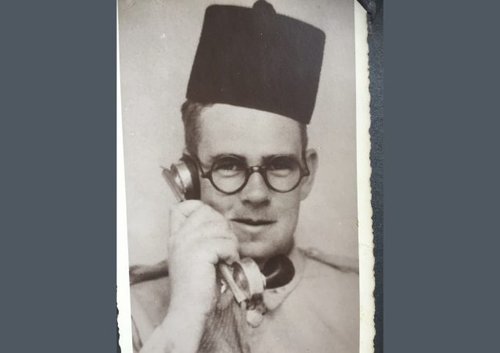
There’s that special kind of Kiwi determination. Sir Ed Hillary tackled Everest and ‘knocked the bastard off’. Dame Valerie Adams was already the greatest, then had two kids, then came back to medal again at the Tokyo Olympics. And then there’s the less-known story of Trooper Ronald Joseph ‘Skin’ Moore. Skin served in North Africa during the Second World War and, following an attack on his patrol, set off with three others on a 200-mile journey through the Libyan desert that became known as ‘Moore’s March’.
The first I learnt of him was a strange wiggle on a lathe-cut disc. One of our Preservation Archivists, Sandy Ditchburn, shared an image of an especially wavy groove on a disc that she spotted through a microscope.

The wavy section is in the middle of the image. The purple mark at the bottom is an optical artefact from pointing a camera into a microscope.
The recording was part of the U Series – a collection of discs recording dispatches from troops in North Africa, the Middle East and Europe. Most of the recordings are messages to loved ones from ordinary soldiers, which were shipped home and played on the radio weeks after being recorded. Others were reportage from the front, eyewitness accounts of battles, and moving waiata sung by members of the Māori Battalion. The discs were given world heritage status in 2020 due to their significant cultural value. (Read more about the U Series here).
Describing the wobble on the disc, Sandy says that it was probably the speaker’s first time using a microphone and they spoke quite loudly in some parts – showing up as wavy patches. ‘The nerves can be seen 80 years later. It’s the great thing about these analogue discs – you can tell so much about how they’ll sound just by looking at them. It’s quite magical.’
After this unusual introduction, I was intrigued to hear the tale that went with it. Despite a shaky start, Trooper Moore soon settles into a natural rhythm, reading his story that would first have been checked by a military censor. It details how, after his Long Range Desert Group patrol was attacked by Italian forces at Jebel Sherif in south-east Libya, Moore and three others began walking toward the allied outpost in Tekro (in the north-east of modern Chad), about 450km to the south.
Moore was wounded in the foot and his mate in the throat. Scrambling to escape the clash, he said, ‘I cannot understand how we were not hit again as the bullets were almost as plentiful as hailstones in a storm’. After laying low, the next day the four men returned to the battle site and salvaged about seven litres of water, but no food. Over the next three days, and with a quarter pint daily ration of water, they trekked the 100 miles to their previous camp, where they found some jam. ‘Certainly there was a lot of sand in it, but it was enjoyed by us all.’ After two companions dropped off, on the eighth day they were spotted by French planes. They dropped some water though ‘to our dismay, the cork came out leaving only about two mouthfuls of water’. Hopes were raised however as they knew help was near.
As French vehicles came to collect him, Skin displayed a ‘she’ll be right’ Kiwi spirit, and was annoyed to have been stopped, so set on reaching his goal. When a patrol picked him up, Adelaide’s The Mail reported ‘He was clear-headed and normal, and waved without stopping because he was determined to reach the base (Tekro) in two more days which, he estimated, he could last out.’
Hearing what unfolded set me on my own trek through records and archives. Trooper Moore has his own Wikipedia page, which speaks to a certain level of notability. As Moore was a New Zealand serviceperson, I checked in with the incredible Online Cenotaph from Auckland Museum, which gave me his service records. Due to the open nature of the Cenotaph, a wonderful photo had been supplied by Sharon, one of Moore’s relatives. I was also able to add details about Moore’s life that were on Wikipedia but not with the Cenotaph.
Passionate researchers and writers before me had already put together resources for their own areas of interest. The Special Forces Roll of Honour had some basic details about Moore, but did also include this photo sporting a de rigueur desert patrol look.
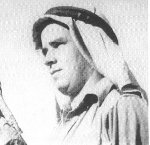
Robin Langford Kay’s ‘Long Range Desert Group in Libya, 1940–41’ included information about ‘Ambush at Gebel Sherif’, those involved and Moore’s March, and is available on Victoria University of Wellington’s New Zealand Electronic Text Collection.
After hearing the story and seeing Moore’s frankly inspiring looks, I tried to imagine following along at the time. This is partly possible through another remarkable resource: the National Library’s Papers Past. How might his family and friends have felt as they scanned the pages of their local paper for updates on their loved ones? It must have been a bumpy journey for them too.
He was first reported as ‘missing, believed killed’ on 10 February 1941:
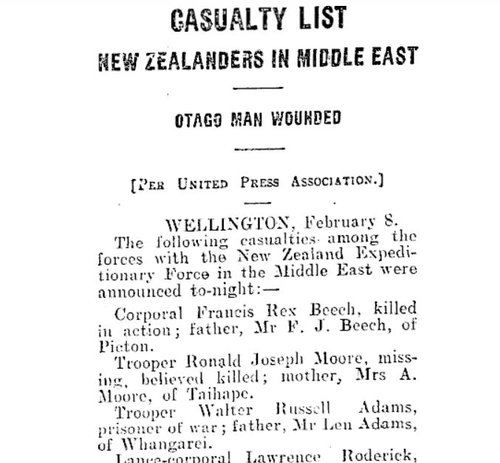
A week later, 18 February, his fate was reported as ‘believed prisoner of war’:
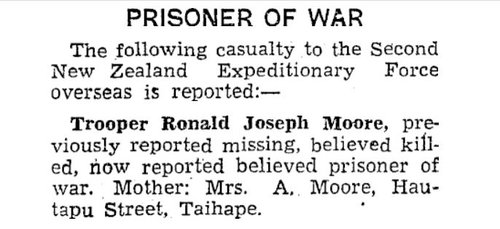
A month after that, on 18 March, his mother and friends must have been delighted to read he was ‘safe and with Allied Forces’:

Finally, another month later, 14 April brought the good news of his receiving of the Distinguished Conduct Medal, and reports of his arduous journey:
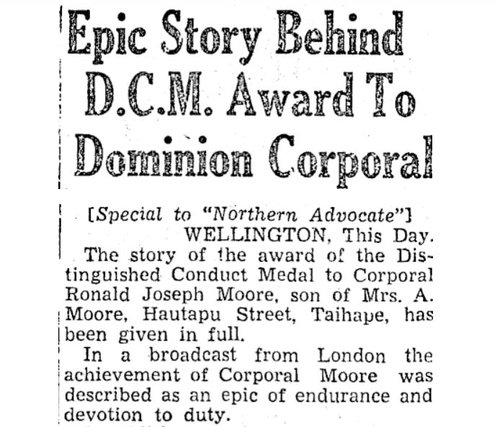
Because I enjoy looking at maps and am not above a tedious – potentially circular – journey, I also tried to follow the journey via Google Maps. This was challenging due to a combination of place names that are in Arabic, French and English. Some of the locations mentioned were geographical features, or small or transient outposts. Set up around oases, it could have been a supply post or a temporary runway. Plus, this recording was during a state of war – I will never be up to speed on the shifting borders, then or now, between Chad and Libya!

Amusingly, Maps is stumped when considering the journey from Jebel Sherif to Tekro: ‘Sorry, your search appears to be outside our current coverage area for walking.’ Then again, they’ve probably not met a tough nut like Skin. His story strikes me as one New Zealand legend that deserves to be better known.
After Moore’s hard slog, he did seem to have been well cared for. He stayed with the French in Sarah and recovered quickly after having lost 12kg in the 10 days of his trek. ‘I was able to enjoy fully my stay with the French,’ he said, ‘and the doctor’s tip about drinking plenty of wine was carried out very well indeed while living with these happy-go-lucky young men of de Gaulle’s.’
Hero image: Trooper Ronald Joseph Moore. Photo courtesy Sharon Harper.